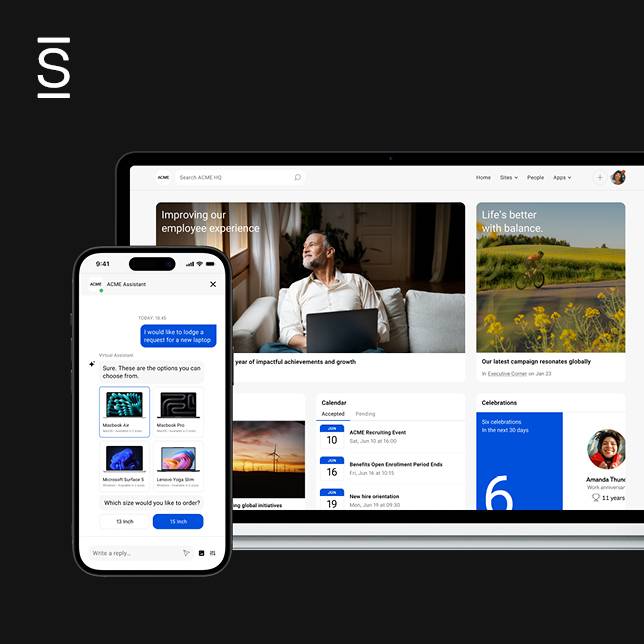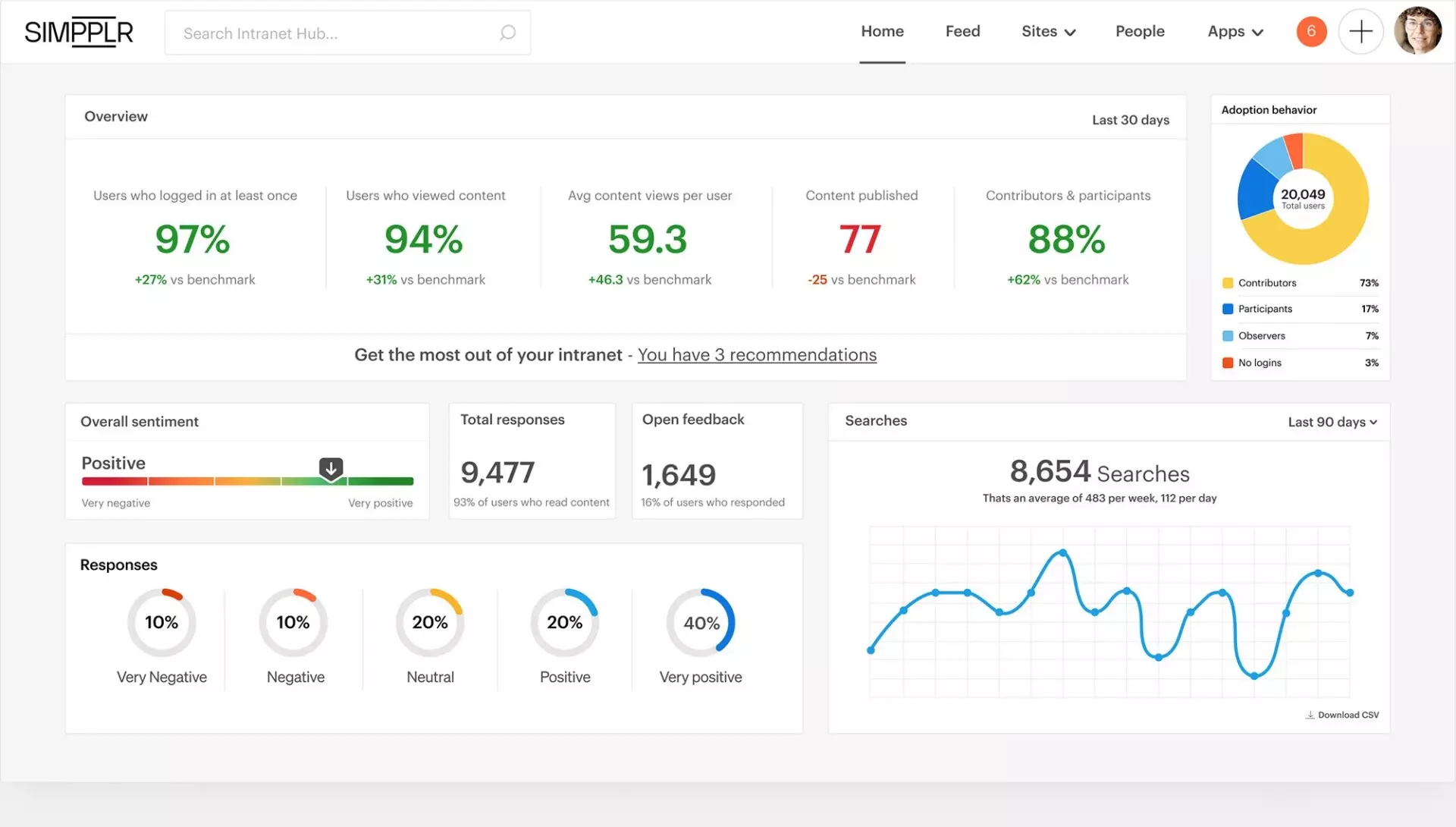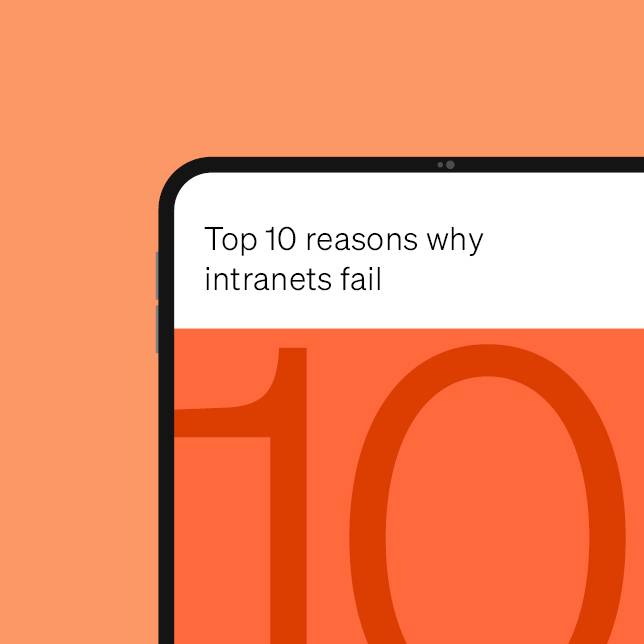- 1 What is employee experience?
- 2 Why is employee experience important?
- 3 How to define your company’s employee experience?
- 4 Employee experience strategy
- 5 Stages of the employee experience journey
- 6 Planning for employee experience success
- 7 Remote employee experience
- 8 Business impact and the bottom line
- 9 Improve employee experience
- 10 Types of employee experience surveys
What is employee experience?
Employee experience (EX) has become a buzzword, but organizations can be sure it is much more than that. In short, employee experience is what it feels like to be in an organization. It’s where employees discover their value, worth, and employer appreciation. But it goes much deeper than that. So, let’s take a closer look.
The employee experience is how an employee experiences your organization through all touchpoints—such as what they learn, see, and do. Additionally, the company’s physical workspace, culture, and technology contribute to employee experience. And a worker’s experience, positive or negative, will ultimately determine whether they are engaged in the workplace and invested in an organization.
Therefore, the goal of those charged with delivering a differentiated EX is to create an optimal work environment so everyone, including the organization itself, can simply flourishTM.
To master employee experience, employers must listen to employees at each stage of the employee’s journey, from onboarding to exit. They should use this insight to identify what is essential to create tailored experiences that fit various employees’ needs.

Watch a 5-minute demo
See how the Simpplr employee experience platform connects, engages and empowers your workforce.
- #1 Leader in the Gartner Magic Quadrant™
- 90%+ Employee adoption rate
Why is employee experience important?
Employee experience has a notable impact on numerous facets of an organization. It’s a domino effect as your employees’ experience will leak into and influence your organization’s performance. These experiences will be reflected in workplace engagement, attracting and retaining talent, and your bottom line.
Engagement
Employee engagement hinges on employees’ emotional commitment and sense of belonging to an organization and its objectives. Measuring engagement is crucial since it reveals how invested employees are and whether or not they will invest their time and energy into the organization.
Gallup reports, “engaged employees produce better business outcomes than other employees—across industries, company size and nationality, and in good economic times and bad.” And that employee engagement is instrumental in lowering turnover rates.
Recruiting
Today, job seekers are pickier about whom they work for. They want to know what to expect. And with online review sites such as Glassdoor growing in popularity, having a solid employee experience is crucial to the hiring process, as former employees are quick to share negative reviews that could damage your reputation and chase away top talent.
Retention
In McKinsey’s Great Attrition research, employees rated three aspects of the employee experience as the top reasons for leaving a job, with each earning equal importance:
- 35% left due to a lack of caring leaders
- 35% left over sustainable work expectations not being met
- 35% left for lack of career development and advancement potential
Other reasons included a lack of meaningful work, unsupportive colleagues and community, and a lack of workplace flexibility. Interestingly, although compensation was in there, it wasn’t a primary reason. Instead, the overall employee experience is what’s central to engaging and retaining workers.
Bottom line
Employee experience correlates to a healthy bottom line. Harvard Business Review found a clear link between employees and revenue, and the impact was substantial. They discovered that by improving employee experience metrics, organizations could increase their revenue by more than 50% and profits almost equally. An investment in employee experience pays off.
How to define your company’s employee experience?
The last few years have affected the way employees think about work. With the great resignation and the ongoing trend of quiet quitting, it’s more important than ever to understand what defines your employees’ experience.
In 2022, 40% of companies were expected to move to a four-day workweek. This move is likely born of employee demand to have a greater balance between work and life. And McKinsey reported that flexibility was a top factor for those who returned to work. But that isn’t the end of changes as the workplace continues to digitally transform and evolve. Defining your organization’s place in these employee experience shifts requires knowing what employees want.
Gallup recently surveyed what employees wanted in a job. The results were telling:
64% of people said a significant increase in benefits/wages was very important
61% said a better work/life balance was very important
58% said that they wanted the opportunity to do what they do best
53% desired excellent stability and job security
42% said that an organization that valued diversity and inclusivity was essential
Your organization is the product here, and employees are buying. Recruiting and retaining the most discerning among them may require redefining your organization’s employee experience.
Employee experience strategy
An employee experience is not defined as a singular moment, but instead should be seen as a journey. And your employee experience strategy influences this journey. It begins at onboarding and includes milestones that encourage and reward exceptional performance.
Unfortunately, this incentive is typically lacking.
Gallup Reports, “only 2 in 10 employees agree that their performance is managed in a way that motivates them to do outstanding work.” With a strategy roadmap, an organization can help employees stay engaged through the stages of their employment journey. Let’s explore those stages now.
Stages of the employee experience journey
As an organization, you’ll need to design an employee experience that focuses on each stage of the employee life cycle. We’ve broken this down into five stages:
1. Attract and Hire:
When it comes to hiring, things to consider will be:
- How long it takes to hire/the cost of hiring
- The rate of offer acceptance
- The quality of hire
Additionally, ask yourself if your ads were attractive. If you were selling a product, you want to be sure you’re marketing to the right person. The same can be said when it comes to hiring. Your company is the product—how are you attracting potential talent to your job descriptions?

Next, you want to think about the application and interview process. Is your messaging concise, uncomplicated, and quick? Was the interview engaging?
2. Onboarding:
Onboarding brings the new hire up to speed on systems, digital workplace tools, workplace expectations, the culture, and more. And even though you want to do this as quickly as possible, this process can take some time. You want to make this an inviting experience that creates a positive initial impression and generates job enthusiasm as this becomes a meaningful connection. And connected employees are motivated to do great things for an organization they feel connected to.
3. Retain:
Now that the employee has successfully been onboarded, your thoughts should turn to retention. An organization can retain engaged employees by inspiring and encouraging them. To accomplish this, part of your strategy may include the following:
Assigning seasoned mentors and coaches that help new employees adapt to the environment.
Presenting clear Key Performance Indicators (KPIs) and achievable goals from the beginning.
Rewarding success with appropriate rewards, recognition, compensation, and additional incentives.
Requesting feedback to improve your employee experience and implementing those suggestions.
Another reason the ideal employee experience is crucial is that it’s expensive to replace employees. According to Yahoo Finance, it costs 33% to two times an employee’s annual salary to replace them.
Check out our blog for innovative employee retention strategies
4. Develop:
Development is an ongoing stage and should be viewed as such. An educated employee is a valuable member of your community. As they develop their organizational roles, you’ll need to analyze their productivity, evaluate their team player abilities, and understand where they see themselves in the future—and you’ll want to provide advancement opportunities.
Motivating your staff could involve continuing education contributions, peer tutoring systems, or collaboration with other departments to promote cross-organizational teamwork, the importance of workplace collaboration, and cooperation to round out their experience.
5. Exit or Churn:
Employees leave for a variety of reasons. Therefore, an employee exit interview is essential. It’s an opportunity to capture candid feedback from those willing to share constructive and detailed information on their work environment and its leaders—and it offers powerful intelligence.
Organizations must balance these five steps with the understanding that their employee is also human and makes mistakes. You can help avoid recurring challenges by developing a strategy ahead of time.

Planning for employee experience success
Your employee experience strategy should be consistent, aligned, and supportive.
Create a consistent experience
Throughout the critical stages of the employee journey, your employee’s experience needs to be consistent with what it offers and how it supports its employees. If an employee trusts an organization to deliver what it says it will, it will boost confidence and promote success.
Align your employee to your goals
Your organization’s goals should be your employees’ goals. However, knowing and understanding these goals are two different things. Employees need to do more than recite the organization’s purpose—they need to understand its practical application to work more confidently and purposefully. Then, create opportunities and events to bring those connections to life, so they view your success as theirs.
Support employees with exemplary leadership
Employees need great leaders, not just nice ones. Leadership who cares for them and knows how to coach them enhances an employee’s productivity and encourages their passion. By focusing on experiences over a list of objectives, organizations create instinctive experiences that revolve around what matters most to employees and your organization’s goals.
Remote employee experience
With so many remote workers today, the employee experience in the workplace has become more challenging. And organizations are relying more heavily on digital workplace tools to help keep the employee experience positive.
Even though employees aren’t coming into the office, many of the objectives are the same such as optimizing onboarding, connecting employees to your mission, and providing professional development opportunities. However, there are challenges unique to remote employees to take into consideration:
- Supporting work/life balance: The lines are blurred more than ever, with full-time caregiving and full-time work overlapping. As a result, offering flexible work schedules and hours may be necessary.
- Keeping the lines of communication open: Communications between leadership and employees significantly impact employee experience. Employees like to know what they’re supposed to be doing at all times; if they don’t, their work will suffer. Messaging and communication tools are crucial here.
- A focus on mental health. With the lines of work and home overlapping, employees are experiencing burnout. Therefore, keeping a pulse on mental health is critical to improving the employee experience and engagement.
- They are connected to company culture. Employees at home may feel alienated from their coworkers and teammates if businesses don’t keep those lines of communication open. A work culture that emphasizes virtual connection, teamwork, and collaboration will keep your employees included.
Lastly, but very important to remote work, workplace tech tools bridge the communication gap and help organizations stay on top of remote employees, ensuring their employee experience is positive.
Check out our blog for ways to engage remote employees
Business impact and the bottom line
Your employees are the handshake to the outside world. And their experience with your organization impacts how firm or unimpressive that handshake can be. In short, happy employees equal more confident interactions within and outside your organization.
Recent research from Harvard Business Review states,“ Companies that perform well on employee experience metrics also tend to perform well on customer experience metrics… improvements in employee satisfaction can drive improvements in customer satisfaction.” It went on to find that stores whose customer-facing employee base was more educated, had more experience, and was higher skilled, generated far more sales per hour.
So, it’s not just about the big moments like promotions and rewards, but the everyday work experience such as having the information needed to complete a job, submitting a report, or requesting time away. The ease and support that employees feel on a day-to-day basis is a big chunk of their employee experience. And they’ll take this with them when they greet a customer or client. And how that interaction goes will affect your bottom line.
Improve employee experience
So, how do you improve and strengthen the employee experience? It doesn’t have to be all at once, but there are a few ways to get this going that we will detail below.
Physical workplace
The physical workspace is the place you can see and touch. It is the art on the wall, the chairs you sit in, and the breakroom. These aspects of the workplace have an impact on employee experience. And that’s because the physical workspace has an emotional impact. Does the atmosphere excite or energize your employees? Or do they feel they’re visiting a doctor’s office? Employees spend a large chunk of their lives at the office, and taking time to make them feel comfortable in that space can lead to happier, more inspired employees.
Invest in employee experience technology
Organizations should be aware of their employee’s digital work experience. How accessible and easy your digital workplace tools are impacts how employees can do their job. If they find themselves blocked by information silos or have to log in and out of multiple apps to access the data they need, they’ll become frustrated and disengaged. This frustration leads to lower productivity. On the other hand, the right digital tools can enhance employee experience by creating a seamless digital work experience from start to finish. This is why it’s vital to design a digital employee experience for today’s workforce.
Build a culture of transparency
Communication across the board should be transparent. And when you have digital tools that work for the employee, creating a culture of transparency is much simpler. For example, with employee experience technology such as a modern intranet, it’s possible to make a digital source of truth that all employees access for their information. Additionally, it can act as a message board for leadership to post any updates or critical communications. And employees can give feedback in this way as well.
Designating leadership
Leadership is a critical component of employee experience. Those you elect to lead your employees need to have company culture in their sights at all times and be effective communicators. They will be the driving force behind your employees’ engagement and inspiration. They need to foster a sense of cohesiveness between teams and individual employees. And they need to support employees in learning new skills. They can make or break your employee experience, so choose wisely.
The importance of listening to employees
Getting feedback from your employees is essential to any organization wishing to foster a cohesive organizational culture. Gathering continuous feedback can provide important information such as:
- The onboarding experience
- Changes in employee experience and morale
- Improvements to be made
- Ways leadership can connect with employees
And there’s a correlation between the feeling of being heard and employee engagement. Research from Forbes shows that “highly engaged employees are three times more likely to say they feel heard at their workplace (92%).” So the importance of listening to employees cannot be overstated.
Check out our blog to learn about the art of listening and the science of learning from feedback
Getting c-suite support
The C-suite often needs to be more hands-on in its employee experience. And many times, it falls to internal communications to get them on board. For example, they may require hard data to help them see why mental health days are critical to the bottom line.
And if employees aren’t supported by organizational leadership to do a good job, their productivity falls, and business will suffer. Having one good conversation and helping the c-suite see and act on that connection can completely change how your employees experience your organization.
Measurement
And, finally, we come to measurement. Measuring employee experience is fundamental; otherwise, you will not know if there are issues to be fixed. Measuring EX locates areas of friction so that you can eliminate it.
There are many ways to measure employee experience, such as focus groups, interviews, surveys, and modern workplace technology like an intranet. Any of these can reveal what drives the employee experience—though some will be more detailed than others. In addition, some will offer more insights into the employee experience, such as trending employee topics, emotions, sentiments, and user connections.
Learn the essential employee experience metrics and KPIs you should be tracking

Remember, the focus is on EX improvements and better business outcomes. So ask yourself, what did we learn? And what steps do we need to take to improve?
Types of employee experience surveys
The best way to improve employee experience is by listening to employees—and personalized employee experience surveys are the best. They come in many forms:
Onboarding surveys
This survey helps you pinpoint areas that may work better for your new employees. These surveys aren’t usually anonymous, as leadership should discuss the survey results with the new hires during an intake meeting in the first few months of their employment to catch any challenges early. And an onboarding survey immediately signals the organization’s interest in employee feedback.
Engagement surveys
These surveys are helpful at the employee retention stage of the employee journey; they reveal how engaged employees feel in their roles and the workplace. In addition, employee engagement influences many aspects of the organization, including customer service, revenue performance, and attrition. As such, it’s crucial to understand employee engagement.
Always on surveys
Daily, “always on” surveys include just a few basic questions about how employees feel. It is often anonymous and can allow employees to provide feedback in a way that makes them feel safe to do so without fear of consequence. Additionally, “always on” surveys capture real-time intel, which reveals company morale and employee satisfaction.
Candidate feedback survey
A candidate’s experience with your organization during the interview process is valuable intel. This data informs future recruitment processes and job postings. And it can provide valuable intel on how most candidates find out about your job openings and what is most appealing to them about the position.
Exit surveys
They came, they saw, they conquered, and they left. Before an employee leaves, an exit interview and survey can provide valuable and candid information on your organization and employee experience. You’ll want to ask questions detailing why employees are leaving, where they are headed, and their experience with your organization.
There is more than one way to create a valuable employee experience. Every organization is different; thus, leaders must think hard to determine what works best for their employees and the organization. This glossary will help you get started.
And when you’re ready to see how Simpplr employee experience platform can add value to your employee experience, reach out for a demo!

Watch a 5-minute demo
See how the Simpplr employee experience platform connects, engages and empowers your workforce.
- #1 Leader in the Gartner Magic Quadrant™
- 90%+ Employee adoption rate







